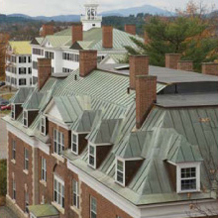Ivy-covered Walls, Copper Roofs Help Keep Tradition Alive
 Aerial view of Richardson Hall, a residence hall, (in foreground) and Dartmouth Hall, home to academic offices and classrooms.
Aerial view of Richardson Hall, a residence hall, (in foreground) and Dartmouth Hall, home to academic offices and classrooms. Photo provided by Joseph Mehling, Dartmouth College
High-resolution version of this photo.
College reunions, for some alumni, are times to have fun, kick back and reminisce about the good old days on campus. For the 30th reunion of the Dartmouth College class of '78, raising a $40 million endowment was just one more item on their agenda.
The $40 million happens to be the price tag for naming a new campus building that will carry their legacy far into the future. The Class of 1978 Life Sciences Center is one of several facilities planned for construction on the Dartmouth campus over the next few years.
The mammoth, 174,500 square-foot building will take its design cues from the "traditional" architecture of the campus. Identifying features include a brick exterior (with or without ivy), granite base and a handsome, pale-green copper roof to cap off the project, according to Steve Campbell, Dartmouth's director of Planning, Design and Construction.
Because it can take years for copper to achieve a green patina-a natural barrier that protects the metal and contributes to its legendary lifespan-the new building's roof will be prepatinated before installation, a process that accelerates the color change. This will allow the structure to more quickly blend into its surroundings.
Copper is visible on most of the roofs across the Dartmouth campus. Originally, slate was predominantly used, but the university gradually transitioned to copper through building additions and renovations. "Copper just seems to fit well with our architecture," explains Jack Wilson, Associate Director of Planning.
Wilson is responsible for selecting architectural materials for Dartmouth. While the college does not have specific architectural guidelines, he feels the campus buildings in general adhere to two existing, predominant styles: neoclassical and neo-Georgian. "You'll find copper on all the pitched roofs on campus," he says. "It really sets the tone."
Within its exterior of copper and brick, the new Life Sciences Center will house an array of laboratories and specialty classrooms that support Dartmouth's commitment to biological research. Included in the structure are features such as a 200-seat auditorium, two-story atrium, 30 "wet" labs, six teaching labs, two 80-seat amphitheater classrooms and a 6,000 square-foot greenhouse.
 Elevation drawings of the new Class of 1978 Life Sciences Center building.
Elevation drawings of the new Class of 1978 Life Sciences Center building. High-resolution version of this photo.
Appropriate to its mission, the Life Sciences Center will be environmentally friendly. The building is expected to consume only half of the energy typically required to operate similar laboratories currently in use in the United States. State-of-the-art energy management and stormwater management systems are key features included in the design.
The project is estimated to cost $93 million when it is completed. The class of '78 is planning to tour their newly named building sometime around March 2010, the proposed opening date.
"The class of '78 is not only extraordinarily generous, but farsighted in enabling the work of students and faculty in critical fields such as life sciences," says Dartmouth president James Wright. "I'm excited by the prospect of having a building that not only is on the (architectural) cutting-edge for the space it provides, but will also be a national model of sustainable design." Cu
Resources:
Also in this Issue:
- New Copper Solar Cells Promise a Bright Future
- Ivy-covered Walls, Copper Roofs Help Keep Tradition Alive
- A 21st Century Coppersmith
- Diet and Depression
